Accurate Electrical Estimate For New Home Construction
When planning an electrical installation project, understanding the cost breakdown is essential for budgeting and decision-making. The cost of wiring and materials, which includes the necessary cables, conduits, and connectors, can range from $8,450 to $21,125. Lighting and fixtures, encompassing both functional and decorative elements, typically add between $2,925 and $7,150 to the overall cost. Outlets and switches, integral for power distribution and accessibility, contribute an additional $4,875 to $12,650. Labor costs, reflecting the expertise and time required by electricians, can vary significantly from $16,055 to $57,280.
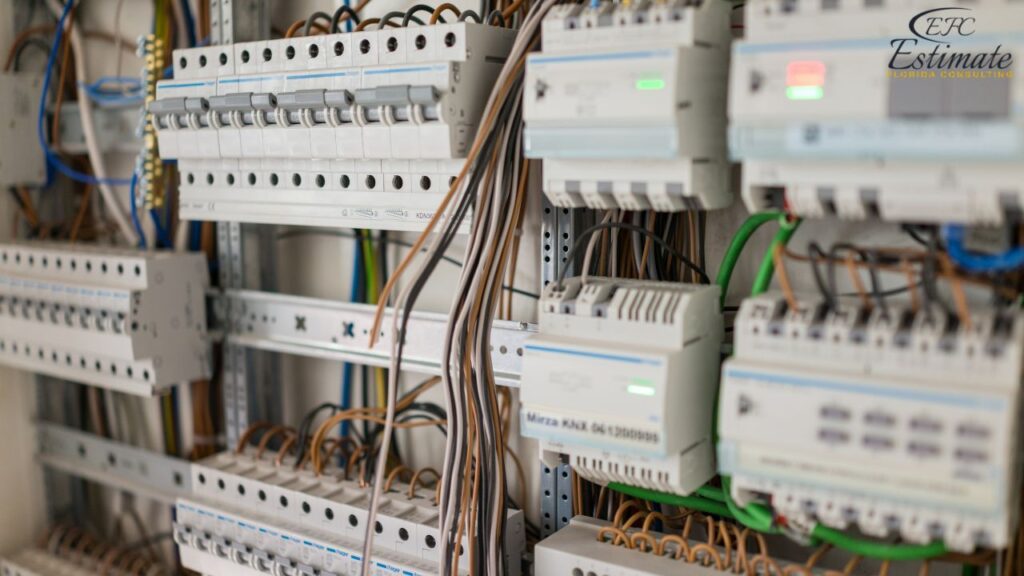
Finally, permits and inspections, crucial for compliance with local building codes, range from $455 to $1,430. Altogether, the total estimated cost for an electrical project can span from $32,760 to $99,635, highlighting the complexity and scope of the work involved.
Detailed Cost Breakdown
Wiring and Materials
Wiring and materials are a significant component of the electrical budget. The type of wiring (e.g., copper or aluminum) and the amount needed depends on the home’s size and layout. Copper is generally preferred for its conductivity and durability, while aluminum may be used in certain applications to reduce costs. In addition to wiring, you’ll need circuit breakers, junction boxes, and other components that contribute to the overall system. The choice of materials should consider factors such as electrical load, safety, and future expansion needs. Using quality materials helps prevent issues like short circuits and increases the lifespan of the electrical system.
Material Type | Estimated Cost per Linear Foot | Total Cost (2,500 Sq Ft Home) |
Copper Wiring | $1.69 – $4.23 | $8,450 – $21,125 |
Aluminum Wiring | $1.30 – $3.38 | $6,500 – $16,900 |
Circuit Breakers | $52 – $130 each | $1,040 – $2,600 (20 breakers) |
Lighting and Fixtures
Lighting and fixtures vary based on style, functionality, and energy efficiency. Costs can range significantly based on preferences and requirements. Selecting energy-efficient LED lighting can reduce long-term utility costs, while dimmer switches and smart lighting systems offer enhanced control and convenience. Consider the ambiance you wish to create in each room, as well as any special lighting needs for areas like kitchens, bathrooms, or home offices. Investing in high-quality fixtures can improve both the functionality and aesthetics of your home, providing a comfortable and inviting environment. LED lighting systems not only lower energy consumption but also last longer than traditional bulbs.
Fixture Type | Low-End Cost | Mid-Range Cost | High-End Cost |
Basic Light Fixtures | $39 – $78 | $98 – $195 | $260 – $650 |
Recessed Lighting | $65 – $130 | $156 – $260 | $325 – $780 |
Ceiling Fans | $130 – $325 | $390 – $650 | $780 – $1,560 |
Outlets and Switches
The number and type of outlets and switches depend on the home’s layout and electrical needs. Consider the placement of outlets for convenience and accessibility, particularly in high-use areas like kitchens and living rooms. Specialty outlets, such as ground fault circuit interrupter (GFCI) outlets, are required in areas with water exposure, such as bathrooms and kitchens, to enhance safety. Dimmer switches and smart controls can provide added convenience and energy savings. Planning for future needs, such as charging stations for electric vehicles, can also influence the number and type of outlets installed. Properly installed outlets and switches ensure ease of use and reduce the risk of electrical fires.
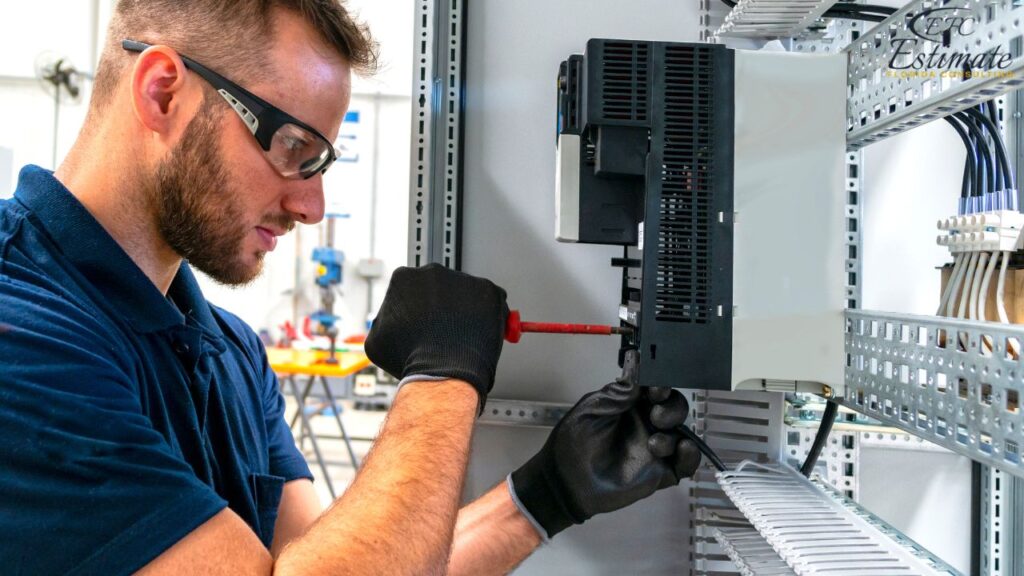
Component Type | Estimated Cost per Unit | Total Cost (150 outlets/switches) |
Standard Outlets | $6.50 – $19.50 | $975 – $2,925 |
GFCI Outlets | $19.50 – $39 | $2,925 – $5,850 |
Dimmer Switches | $13 – $32.50 | $1,950 – $4,875 |
Labor Costs
Labor costs include the electrician’s hourly rate and the time required to complete the work. Complex installations or modifications can increase the number of hours needed, affecting overall expenses. It’s essential to obtain detailed quotes from multiple contractors to understand labor costs and ensure that all aspects of the project are covered. Some electricians may charge a flat fee for certain tasks, while others bill by the hour, so understanding their pricing structure is key to accurate budgeting. Additionally, scheduling and coordinating labor effectively can prevent delays and keep costs in check. Labor costs should cover everything from initial wiring installations to the final inspection.
Task | Estimated Hours | Cost per Hour | Total Cost Estimate |
100 – 200 | $84.50 – $156 | $8,450 – $31,200 | |
Fixture Installation | 40 – 80 | $84.50 – $156 | $3,380 – $12,480 |
50 – 100 | $84.50 – $156 | $4,225 – $15,600 |
Permits and Inspections
Permits and inspections ensure compliance with local codes and standards. These steps are essential to verify that the electrical work is safe, efficient, and adheres to current regulations. Inspections provide an opportunity to catch potential issues early, preventing costly repairs or hazards down the line. The cost of permits and inspections may vary by region, but they are a necessary part of the construction process to protect both homeowners and contractors. Working with a professional electrician who is familiar with local requirements can streamline the permit process and ensure that all work is completed to the highest standards. Meeting all inspection criteria is crucial for avoiding fines and ensuring that the electrical system functions safely.

Permit Type | Estimated Cost |
Electrical Permit | $195 – $650 |
Inspection Fee | $260 – $780 |
Planning Your Electrical System
Understanding Your Needs
Before diving into the details of your electrical estimate, it’s crucial to understand your specific needs and lifestyle requirements. Consider the number of rooms in your home, the appliances you’ll be using, and any special features like home theaters, outdoor lighting, or smart home systems. Anticipating future needs, such as electric vehicle charging stations or solar panel installations, can also influence your planning. By having a clear picture of your electrical requirements, you can better communicate with your contractor and ensure the system is designed to accommodate your family’s needs. Proper electrical load calculations are essential to ensure the system can handle the demand without overloading.
Setting a Realistic Budget
Establishing a realistic budget for your electrical system is essential for successful project management. Start by assessing your overall construction budget and allocating a portion specifically for electrical work. Consider both immediate expenses, such as wiring and fixtures, and long-term investments in energy efficiency and smart technology. It’s important to include a contingency fund for unexpected costs, which are common in construction projects. A well-planned budget will help you make informed decisions and avoid overspending, ensuring that the project remains on track and within financial constraints. Factoring in costs for circuit breaker installation and necessary electrical code compliance is also crucial.
Get Acquainted with Electrical Installations
Electrical House Wiring
HVAC Installation
Electrical Wiring of 3 Storey House
Download Template For Electrical Project Breakdown
- Materials list updated to the zip code
- Fast delivery
- Data base of general contractors and sub-contractors
- Local estimators
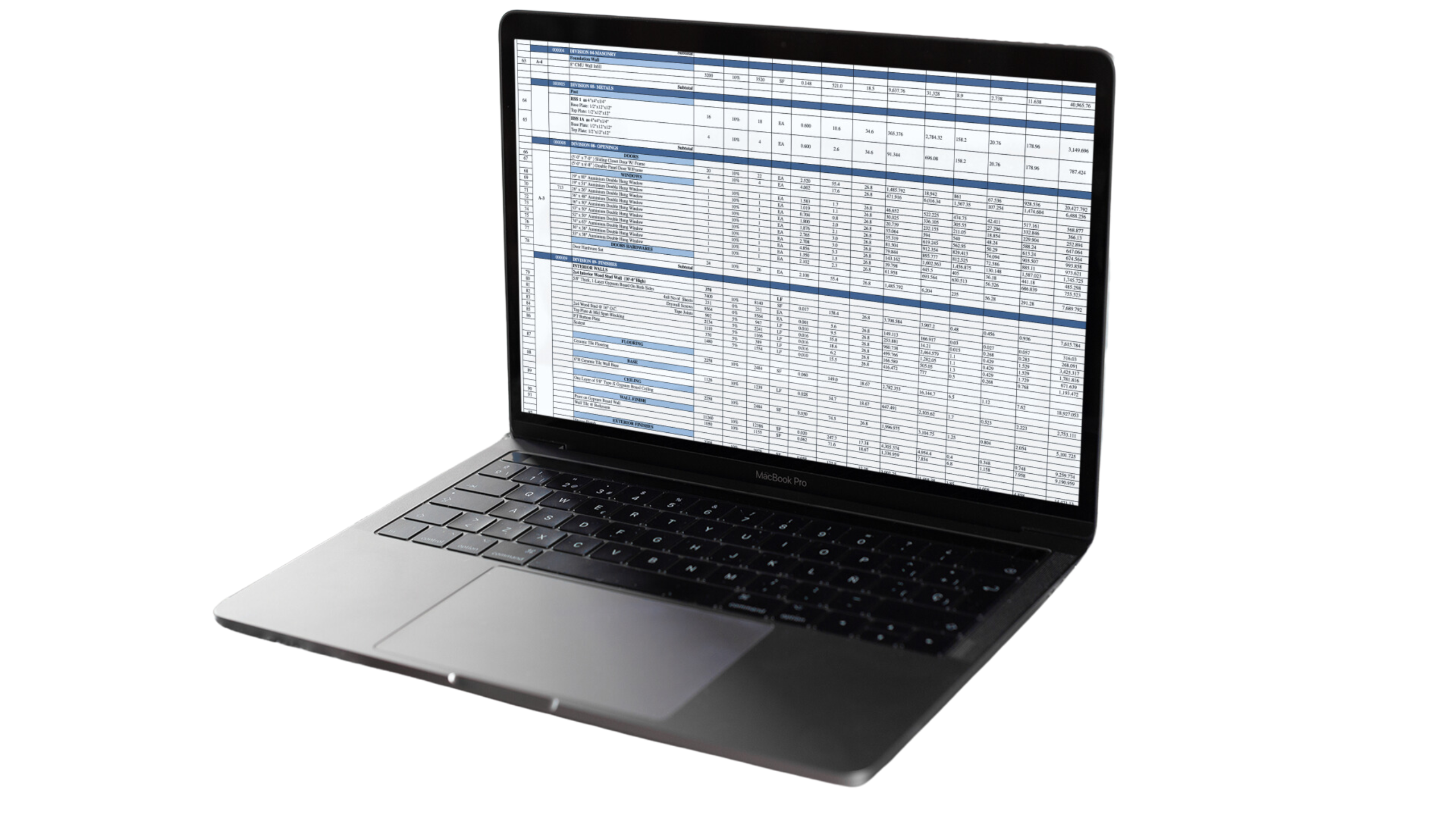
Key Factors Influencing Electrical Costs
Home Size and Layout
The size and layout of the home significantly impact electrical costs. Larger homes require more wiring, outlets, and fixtures, increasing both material and labor expenses. The complexity of the layout also affects costs, as homes with multiple stories, unique architectural features, or extensive outdoor lighting may require additional wiring systems and electrical components. When designing your home’s layout, consider factors such as the number of circuits needed, the placement of outlets and switches, and the integration of lighting control systems. A well-thought-out layout can optimize energy efficiency and enhance the overall functionality of your home.
Quality of Materials and Fixtures
The quality and type of materials and fixtures chosen can greatly influence the total cost. High-end fixtures, energy-efficient lighting, and advanced home automation systems tend to cost more but offer long-term savings and enhanced functionality. Choosing high-quality wiring, such as copper, ensures durability and reduces the risk of electrical issues. While premium materials and fixtures may have a higher upfront cost, they often provide better performance, aesthetic appeal, and longevity. It’s important to balance initial expenses with the benefits of durability, energy efficiency, and resale value. Using advanced lighting systems can also contribute to energy savings over time.
Labor Costs
Labor costs vary based on the region, complexity of the work, and the experience of the electricians. Hiring licensed and experienced professionals ensures that the electrical system is installed safely and efficiently, reducing the risk of future issues. Skilled electricians are familiar with local codes and regulations, ensuring compliance and avoiding potential legal problems. When selecting a contractor, consider their reputation, references, and the scope of services offered. Obtain detailed quotes from multiple contractors to compare labor rates and ensure you receive the best value for your investment. Labor costs should account for the installation of key components, including wiring systems and circuit breakers.
Code Compliance and Permits
Ensuring compliance with local electrical codes and obtaining necessary permits are crucial steps in new home construction. These requirements may add to the overall cost but are essential for safety and legality. Electrical codes dictate the standards for wiring, circuit design, and fixture installation, ensuring that the system is safe and reliable. Permits are typically required for new installations and significant modifications, and they often involve inspections by local authorities. While these processes may seem cumbersome, they provide peace of mind and protect your investment by ensuring that the work meets all necessary standards. Compliance with the National Electrical Code (NEC) is particularly important to prevent hazards and ensure the safety of the home’s occupants.
Different Types Of Electrical Projects
Office Building Wiring and Lighting Installation
When it comes to office building wiring and lighting installation, ensuring a well-designed and functional system is crucial for productivity and energy efficiency. A comprehensive wiring plan involves installing the necessary electrical infrastructure to support various office equipment, data systems, and lighting fixtures. This includes running conduits, setting up outlets, and integrating advanced technology for seamless connectivity. Costs for wiring an office building can now range from $3.90 to $6.50 per square foot, depending on the complexity and technology involved. Lighting installation focuses on providing adequate illumination for workspaces while incorporating energy-efficient solutions, such as LED fixtures and smart controls, to minimize operational costs. Installing LED lighting in an office can now cost between $130 to $260 per fixture. Properly planned wiring and lighting not only enhance the overall office environment but also contribute to a safer and more comfortable workspace for employees.
Retail Store Electrical Setup
A well-executed retail store electrical setup is essential for creating an inviting and functional shopping environment. This involves installing a robust electrical system to power lighting, point-of-sale terminals, refrigeration units, and other essential equipment. Electrical setup costs for a retail store now typically range from $5.20 to $10.40 per square foot. Key considerations include strategically placing electrical outlets for customer convenience and staff efficiency, as well as incorporating energy-efficient lighting solutions to highlight merchandise and enhance store aesthetics. The cost of installing energy-efficient lighting in a retail space can now range from $156 to $325 per fixture. Additionally, integrating advanced control systems, such as automated lighting and climate controls, can now cost between $2,600 to $13,000, depending on the system’s complexity, and helps optimize energy use and create a dynamic shopping experience. A professionally designed electrical setup not only supports daily operations but also contributes to a welcoming atmosphere that can boost customer satisfaction and sales.
Warehouse Electrical Upgrades
Warehouse electrical upgrades are crucial for enhancing operational efficiency and meeting the demands of modern inventory management. Upgrading the electrical system involves installing higher-capacity wiring and circuit breakers to accommodate advanced equipment such as automated storage systems, high-intensity lighting, and specialized machinery. Costs for warehouse electrical upgrades can now range from $7.80 to $13 per square foot, depending on the extent of the upgrades. Improvements may also include upgrading to energy-efficient lighting solutions, like LED fixtures, which now typically cost between $195 to $390 per fixture, to reduce operational costs and improve visibility. Additionally, integrating smart controls and monitoring systems, now costing between $3,900 to $19,500, can provide real-time data on energy consumption and system performance, allowing for proactive maintenance and optimization. These upgrades not only ensure a safer and more reliable electrical infrastructure but also support the overall productivity and scalability of warehouse operations.
Restaurant Electrical Installation
Restaurant electrical installation is vital for creating a functional and efficient dining environment. This involves setting up a comprehensive electrical system to power kitchen equipment, dining area lighting, and point-of-sale systems. Costs for restaurant electrical installation now typically range from $9.10 to $15.60 per square foot. Key aspects include installing high-capacity circuits to handle commercial-grade appliances like ovens, refrigerators, and dishwashers, which can now cost between $2,600 to $6,500 for the electrical work alone, as well as integrating energy-efficient lighting solutions to enhance the ambiance and reduce operating costs, now typically costing $130 to $325 per fixture. Additionally, proper wiring and outlet placement are essential for both safety and convenience, ensuring that all areas of the restaurant are adequately supported. A well-planned electrical installation not only ensures smooth daily operations but also contributes to a pleasant dining experience and complies with health and safety regulations.
Shopping Mall Electrical Installation
Shopping mall electrical installation is a complex process that requires meticulous planning to ensure a safe, efficient, and aesthetically pleasing environment. This installation involves setting up a robust electrical infrastructure to support diverse needs, including high-intensity lighting for common areas, power for retail stores, and HVAC systems for climate control. The cost of wiring a shopping mall can now range from $13 to $26 per square foot, depending on the complexity. The process also includes installing and wiring advanced security systems, escalators, and elevators, with costs for security systems typically now ranging from $6,500 to $65,000 and elevator wiring costing between $19,500 to $52,000. Energy-efficient solutions, such as LED lighting and smart building controls, are integrated to enhance operational efficiency and reduce energy consumption, with lighting installation now costing between $195 to $390 per fixture. A well-executed electrical installation ensures reliable performance and contributes to a positive shopping experience, making the mall a comfortable and secure place for both shoppers and staff.
Additional Considerations
Energy Efficiency Upgrades
Investing in energy-efficient upgrades can reduce long-term utility costs and increase the home’s value. Consider installing LED lighting, smart thermostats, and advanced home automation systems. These upgrades not only lower energy consumption but also offer enhanced comfort and convenience. For example, smart thermostats can learn your preferences and adjust heating and cooling schedules to optimize energy use. Solar panels and battery storage systems can further enhance energy efficiency, providing renewable energy options and potential cost savings. While these upgrades may have a higher upfront cost, they often pay for themselves over time through reduced energy bills and increased property value. Advanced energy management systems can also allow you to monitor and control energy usage remotely.
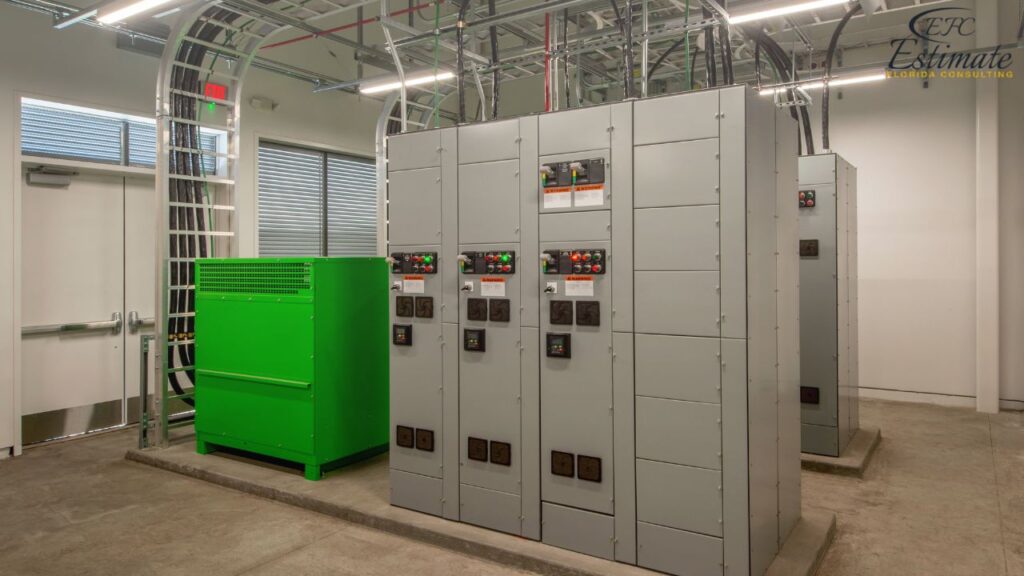
Upgrade Type | Estimated Additional Cost |
LED Lighting | $390 – $1,300 more |
Smart Thermostats | $260 – $650 more |
Home Automation Systems | $1,300 – $6,500 more |
Unexpected Costs
During construction, unexpected issues such as faulty wiring or additional requirements may arise, increasing costs. It’s wise to budget an extra 10-15% of the total estimate to account for these unforeseen expenses. Identifying potential problems early and maintaining open communication with your contractor can help mitigate unexpected expenses and keep the project on schedule. Properly addressing unexpected issues can prevent long-term problems and ensure that the home’s electrical system is robust and reliable.
DIY vs. Professional Installation
While some homeowners may consider DIY electrical work to save money, professional installation is recommended to ensure safety and compliance with codes. Incorrect installations can lead to costly repairs and potential hazards. A professional electrician brings expertise and experience, ensuring that all work is completed to high standards. They also provide warranties on their work, offering additional assurance. Attempting complex electrical tasks without the necessary skills and tools can result in more significant expenses down the line if errors occur. Professional installation guarantees that the system is safe, efficient, and compliant with local regulations.
Get 5 New Leads Next 7 Days With Our System
- Multi-Family House
- Single-Faimly House
- Modern House
- Duplex
- Ranch House
- Bungalow
Conclusion
Creating an accurate electrical estimate for new home construction requires careful consideration of various factors, including materials, labor, and compliance with local codes. By understanding these components and working with experienced professionals, homeowners can ensure that their new home’s electrical system is safe, efficient, and meets their needs. Thorough planning and budgeting can help prevent unexpected costs and delays, resulting in a successful construction project that enhances the home’s functionality and value. With the right approach, your new home will be equipped with an electrical system that supports your lifestyle and future technological advancements.
FAQs
An electrical estimate typically includes costs for wiring and materials, lighting and fixtures, outlets and switches, labor, and permits and inspections. The total estimated cost for an electrical project can range from $32,760 to $99,635, reflecting the complexity and scope of the work involved.
Wiring and materials are significant components of the electrical budget. The type of wiring (e.g., copper or aluminum) and the amount needed depend on the home’s size and layout. Copper is preferred for its conductivity and durability, while aluminum may be used to reduce costs. Quality materials help prevent issues like short circuits and increase the system’s lifespan.
Here is the estimated cost breakdown for wiring materials:
- Copper Wiring: $8,450 – $21,125
- Aluminum Wiring: $6,500 – $16,900
- Circuit Breakers: $1,040 – $2,600 (20 breakers)
Lighting and fixtures vary based on style, functionality, and energy efficiency. Costs can range significantly based on preferences and requirements. Energy-efficient LED lighting can reduce long-term utility costs, while smart lighting systems offer enhanced control and convenience. High-quality fixtures improve both the functionality and aesthetics of your home.
Here is the estimated cost breakdown for lighting fixtures:
- Basic Light Fixtures: Low-end: $39 – $78, Mid-range: $98 – $195, High-end: $260 – $650
- Recessed Lighting: Low-end: $65 – $130, Mid-range: $156 – $260, High-end: $325 – $780
- Ceiling Fans: Low-end: $130 – $325, Mid-range: $390 – $650, High-end: $780 – $1,560
The number and type of outlets and switches depend on the home’s layout and electrical needs. Proper placement ensures convenience and accessibility. Specialty outlets, such as GFCI outlets, enhance safety in areas with water exposure. Planning for future needs, like electric vehicle charging stations, can influence costs.
Here is the estimated cost breakdown for outlets and switches:
- Standard Outlets: $975 – $2,925
- GFCI Outlets: $2,925 – $5,850
- Dimmer Switches: $1,950 – $4,875
Labor costs are based on the electrician’s hourly rate and the time required to complete the work. Complex installations can increase the number of hours needed. Obtain detailed quotes from multiple contractors to understand labor costs and ensure comprehensive coverage of all tasks.
Here is the estimated labor cost breakdown:
- Wiring Installation: 100 – 200 hours, $84.50 – $156 per hour, Total: $8,450 – $31,200
- Fixture Installation: 40 – 80 hours, $84.50 – $156 per hour, Total: $3,380 – $12,480
- Outlets/Switches Installation: 50 – 100 hours, $84.50 – $156 per hour, Total: $4,225 – $15,600
Google Reviews

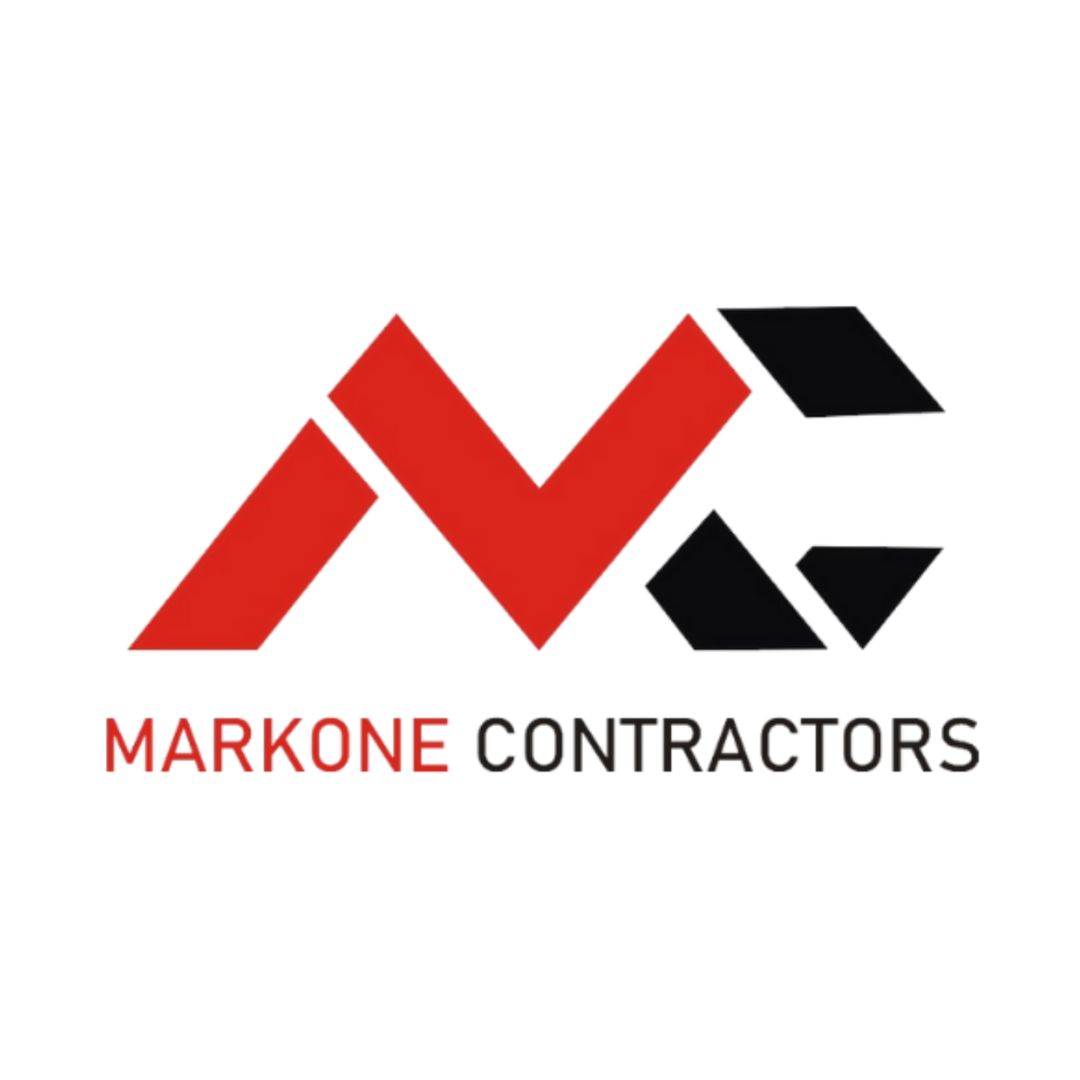

Process To Get Electrical Cost Estimate Report
Here I am going to share some steps to get electrical cost estimate report.
-
You need to send your plan to us.
You can send us your plan on info@estimatorflorida.com
-
You receive a quote for your project.
Before starting your project, we send you a quote for your service. That quote will have detailed information about your project. Here you will get information about the size, difficulty, complexity and bid date when determining pricing.
-
Get Estimate Report
Our team will takeoff and estimate your project. When we deliver you’ll receive a PDF and an Excel file of your estimate. We can also offer construction lead generation services for the jobs you’d like to pursue further.

